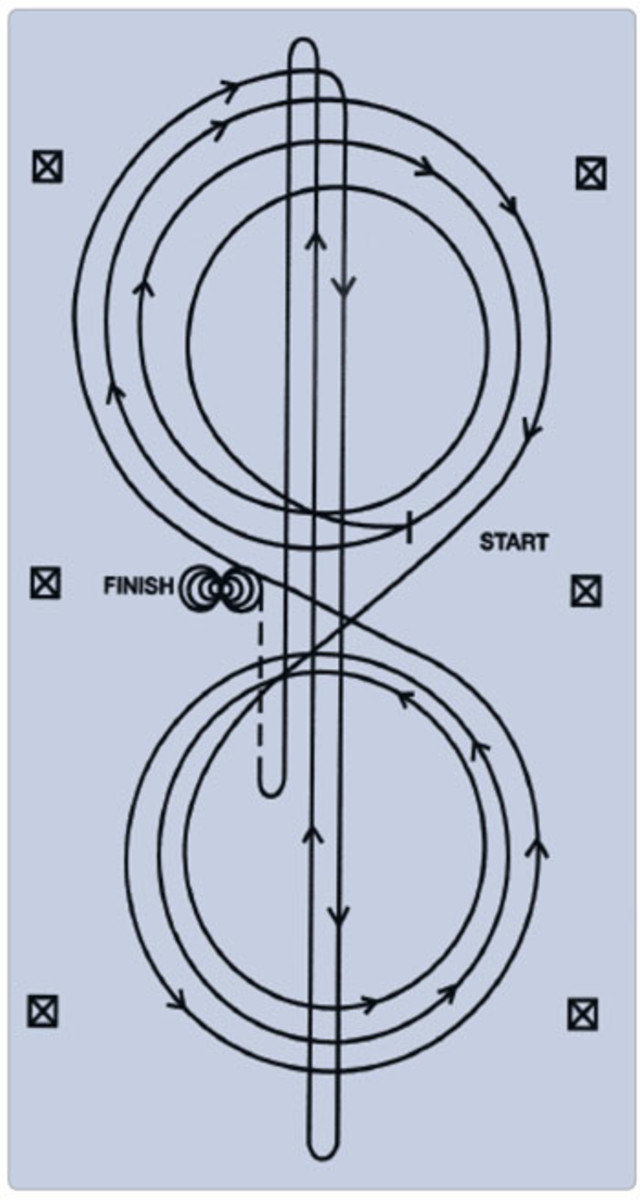Read your rulebook before riding this pattern to understand what’s expected in each maneuver and what the various penalties are. Also, familiarize yourself with the arena you’ll be performing in, noting where you’ll be executing your maneuvers and establishing reference points.

This pattern begins at the middle markers, but as soon as you enter the arena, I’m judging you. You may walk or trot to your starting position—trotting wastes less time, but if your horse performs better by walking in, that’s fine. It’s possible to score a zero for the entire pattern even before beginning it, if you switch hands on your reins. You must perform the entire pattern holding your reins in the same hand. If you change your rein hand during the pattern or enter the ring riding two-handed and later hold them in one hand, you’ll earn a zero score.
Exhibit a full halt before beginning the pattern, or incur a 2-point penalty. To score well, perform a smooth, straight and steady lope departure. I don’t mind seeing two or three walk steps, but any trot steps incur penalties. If your horse can smoothly pick up the lope from a standstill he’ll show a higher degree of difficulty and I’ll consider it toward a plus score for the whole maneuver.
The right circles are first, so make sure you get the right lead to begin. If not, you’ll incur a 1-point penalty for each quarter circle you’re on the wrong lead. Breaking to the trot to correct the lead incurs a 2-point penalty, so it’s better to get a flying lead change.
The small, slow circle is first, and should be symmetrical, pleasing to the eye, coordinated and collected. Maintain good forward motion—I don’t want to see a slow pace so collected that it looks artificial. I also don’t want to see a cramped small circle, so tiny and tight that I can’t see your horse moving freely.
Return to the arena’s center as you close your small circle or your circles will be off-center in the pattern. If they’re off-center, even beautiful circles will earn only a zero maneuver score, and mediocre circles will earn a negative score.
Keep your large circles symmetrical but distinctly larger than the small circle. I shouldn’t have to guess which size you’re showing me. The fast pace shouldn’t be breakneck. Know how much speed your horse can show without losing form and control, and don’t push him past it. Often, when horses run too fast, their hind legs work too closely together so their hind lead becomes indistinct. Keep control first, then add speed if your horse is capable.
I like to see a horse bend from nose to tail just enough to follow the arc of the circle. His head shouldn’t be tipped to the outside, or too far to the inside. He should carry his head at a height that’s natural for his build, rather than artificially low or over-fixed. I don’t mind light rein contact, but if he goes beautifully on a little drape, I’ll score him higher. Maintain the same rein length throughout the pattern.
Perform your flying lead change at the middle markers—too early or too late incurs penalties. The lead change should be smooth, straight, and level without your horse hopping into the air to change, and without you having to throw him onto it. He should change with his front and hind legs simultaneously.
The danger point of this pattern is coming out of the large fast circle to the right and dropping right back to a small, slow circle after your lead change. Your horse must respond readily and drop obediently down into the slower pace. The left circles should have the same qualities of the right circles regarding size, symmetry, pace, and form.
Maryann Willoughby operates Willoughby-Henson Training Stable in Hugoton, Kansas, with her husband, daughter, and son-in-law. As a judge for the AQHA, APHA, ApHC, PHBA, PtHA, POA, NASMA, NSBA, NRHA, and NRCHA, she judges more than 30 shows per year, and has presided at many national level shows including the APHA World Show and the ApHC World Show.






